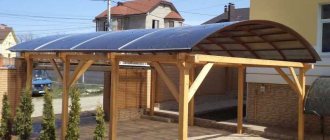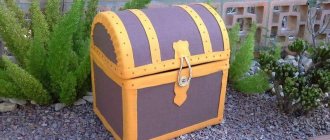When you are relaxing in the country, or you are just a rural resident, you may encounter the following problem - the Internet does not work well or does not receive a signal at all. In this case, there are ways to solve this problem, for example, USB extenders that can be used to raise the 3G modem to some height. But the most effective way to strengthen 3G or even 4G Internet is Internet signal amplifiers - special antennas and repeaters for modems. But after purchasing such amplifiers, the problem arises - how to secure them. There are many such ways to secure an antenna. You can use brackets to mount it on the wall of the house, but it is low on the wall, and the higher the amplifier, the better the Internet signal and the higher the Internet speed, so it would be better to mount the antenna on the roof of the house itself. This way the antenna will be located higher, and, accordingly, the signal will be better and the speed will be higher. This is exactly the kind of bracket that will be discussed in this article. And in order to make such a roof bracket for an Internet amplifier we will need:
Tools:
1) Wood saw, 2) Plane, 3) Metal saw, 4) Electric drill and bits, 5) Screwdriver, 6) Axe, 7) Nuts and bolts, Hammer and six nails.
Hammer and six nails.
Materials:
1) A not very thick pole approximately 1.5 m long, 2) A metal plate with holes, 3) A metal pipe.
The process of making a bracket for a 3G amplifier on the roof of a house with your own hands.
To make a bracket for a 3G amplifier on the roof of a house, we will need a thin pole approximately 1.5 m long.
We clean it with a plane from the top layer.
Next, we take a rigid metal plate with holes and bend it at a certain angle. With the help of this metal plate the pole will be fixed to the roof, so the bending angle should be such that the pole on the roof stands straight and level. Now we need an iron pipe, also about 1.5 m long. Using a metal cutting saw, we cut it into two equal pipes. After cutting the pipe in half, flatten both ends of each resulting pipe with a hammer. Now we bend the flattened places at a certain angle, also depending on the slope of the roof. Using an electric drill, drill holes in the flattened areas. At one end we drill two small holes for self-tapping screws, and at the other end we drill one hole for a self-tapping screw, and one hole with a larger diameter for a bolt. We perform these actions on both pipes. Everything, all the necessary parts and components are prepared. All that remains is to assemble the bracket and secure it to the roof of the house. We take self-tapping screws and use a screwdriver to secure the metal plate with holes on the pole, but before this action, use an ax to make a recess on it to secure the plate. In another place on the pole we make a hole for a bolt to secure the pipe holders. We also make a small recess where the hole was drilled. Take a bolt, two washers and two nuts to secure the bracket posts. We secure them using keys. I took two nuts because it would be more reliable. Next, we also screw in the self-tapping screws so that everything holds tightly. The bracket is ready. Now we need to fix it on the roof of the house. You can use simple nails for this.
In the era of the heyday of satellite and cable television, especially for citizens living in apartment buildings, the issue of installing a television antenna on the roof practically no longer arises. This problem is still relevant for arranging television broadcasting in a country house or in a private house outside the city. Satellite TV is an expensive thing, not every person will allow themselves to spend a lot of money on buying a satellite television receiver as a summer cottage option, so the rational way out would be to purchase an analog receiver and fix it with your own hands. In this article we will tell readers how to install an antenna on the roof of a private house.
Antenna mounting options
After the antenna has been purchased, before installation, you need to make sure that the fasteners are available and pre-treat its threaded part with lithol or machine oil, or, in extreme cases, silicone grease or WD-40. If you decide to install an active antenna, to prevent oxidation of the contact points, it is recommended that after completing the cable connection to the electronic board, seal it with waterproof silicone.
Depending on the power and direction of the television signal, a decision is made on the location and height of the antenna installation. In practice, the two most popular options are: on the facade of the house and on the roof. Let's consider both installation technologies.
On the facade of the house
The simplest and least labor-intensive option. You can install a television antenna on the facade yourself without anyone’s help, but this method has a significant drawback. To ensure reliable reception, the signal from the nearest repeater must be of such strength that the receiving device does not need to be raised high. The choice of this installation option is limited by the material and decoration of the walls of the house. Installation on siding cannot be carried out and is very problematic on aerated concrete masonry. The ideal option for installing an antenna on a facade wall is when it is made of brick or wood. When performing installation, maintain a distance between fasteners of no more than 1.5 meters. It is recommended to use anchor bolts or self-tapping screws as fastening materials.
- Receiving antenna device.
- Metal pipe or wooden beam.
- Bracket.
- Anchor bolt (self-tapping screw).
Photo examples of installing a signal receiver on the facade:
The video below clearly demonstrates how to install a receiving antenna device on the facade of a house:
The transmission of information via electromagnetic waves in the radio frequency range has become commonplace in the life of modern man. Without this type of communication it is impossible to imagine civilization in general: television, telephones, radio, navigation and control equipment, as well as many other attributes of our everyday life could not exist without radio waves.
Without going into the physics of the propagation and transmission of radio signals, we note: in order for this type of communication to work, a special kind of device is required that transmits and receives signals. Transmitters, as a rule, are rarely used by the average person, but receivers are used everywhere.
A necessary element of the receiver is the antenna, and even if you don’t see it, for example, on a cell phone, this does not mean that there is no antenna, it’s just hidden inside the case. Unfortunately, this is not always possible.
We won’t tell you what the problem is here - this is a topic from a course in physics and radio electronics, and therefore it is of little interest to a person far from these issues.
However, we note: in some cases, for example, to receive a television or satellite signal, the antenna itself is quite large in size, and it must be installed at a certain height and oriented in a special way in space. In order for these conditions to be met, a special design is used - an antenna bracket.
You can look at photos of the antenna bracket on specialized websites - they will give the most general idea of what it is. To fully understand this issue, you need to know more, and therefore we will dwell on this topic in more detail and reveal some, not entirely obvious, aspects: knowing them will save you from unpleasant and unnecessary “surprises”.
TV antenna for a summer residence: where and how to install
Before you begin installing an antenna in a private home, determine the location of the nearest tower or repeater. You can do this by indicating your location on the CETV coverage map
Once you know the mileage, you can buy equipment. What you will need to install outdoor antennas:
Antenna, if you follow our advice, then one of the following; Coaxial cable (RG 6 professional steel, SAT 703, SAT 50 copper); F connectors, TV plug (according to the number of connections); Lightning protection on the cable (optional, but if you want to install an antenna on a mast, it’s better to put it on the price of 300-350 rubles) Bracket or mast; Ties and clips for fastening the cable; Device, digital set-top box with TV or TV with dvb-t2 support for setup; TV signal amplifier and dividers (if required) .Fasteners for bracket or mast. Decide for yourself which fasteners will suit you (screws, studs, anchors, etc.)
d.).Puncher or drill, drill or drill with a diameter of 8 mm. under the cable. A knife for stripping cables, wire cutters and, depending on the circumstances, what may be required.
Everything about the equipment. You determined where to go from the map. Next, we will consider options for installing television antennas.
Necessary conditions for confident reception
One of the prerequisites for successful and reliable reception in the vast majority of cases, for example, for receiving satellite and television signals, is direct visibility between the transmitting and receiving antennas.
What does this mean? It's simple: the transmitting antenna, for example, a TV tower, is installed at the highest point of the landscape, this achieves the maximum coverage area, and the receiving antenna is yours. The main thing is that there should be no obstacles between these two antennas: hills, buildings, poles, fences, etc. That is, the signal from the transmitting station reaches the receiver along a forward vector, without encountering obstacles.
That is why the antennas are placed high above the ground: the higher, the less likely there is an obstacle between the transmitting and receiving antennas.
It is important to note here: if your house is located on a mountain, i.e., there are no obstacles between it and the transmitting station, then there is no point in “raising” the antenna high; a high location will not give any effect. It will be enough to use a simple bracket for the antenna on the wall, raising it 2-3 meters.
Otherwise, when the antenna is installed in a lowland, a sufficiently high mast is required to provide direct visibility, which will ensure reliable reception of a signal of sufficient strength.
The next thing you need to know about is directionality. In this case, we are dealing with the need to accurately orient the receiving antenna to the transmitting one. In other words: the receiving side of the antenna must be directed strictly in the direction of the transmitting station, this achieves the maximum level of the useful signal.
In some cases, in addition to positioning in the horizontal plane, clear orientation is also required in the vertical plane, in particular: the bracket for a satellite dish must provide for adjustment in both planes, and do this with high accuracy.
Another prerequisite is sufficient structural strength. When exposed to external factors: wind, shocks, precipitation, etc., the antenna must maintain its position and also not pose a danger to others.
For safety reasons, when installed outdoors, at a sufficiently high altitude, it is necessary to provide protection against lightning strikes, which will avoid damage to equipment, the possibility of fire and electric shock to people during a thunderstorm.
Lightning protection of antennas: lightning rod design
Lightning protection of outdoor antennas requires mandatory grounding. If the antenna is located within the range of the lightning rod at home, it does not need to be grounded.
The design of a lightning rod consists of three main parts: an air terminal, a down conductor and a grounding conductor.
The lightning rod can be made from a steel rod (diameter 12-15 mm) with a square section (10 x 10 mm) or a water pipe (gas pipe). In the latter case, the upper end of the pipe is flattened. The cross-sectional area of the lightning rod is at least 100 mm2, length 0.3-1.5 m.
The down conductor connects the lightning rod to grounding. This is either a strip of steel (cross section of at least 40 mm2) or a cable of the same cross-section. The wiring of the down conductor depends on the design of the lightning rod.
When manufacturing any lightning rod, the following must be observed:
Ground electrodes can be vertical or horizontal; in the first case, pipes (rods) are driven 2-3 m into pits (0.8 m deep), then the pits are filled up; in the second, pipes, pieces of iron, coils of thick wire, etc. are placed in holes of the same depth. The length of the horizontal pipe depends on the soil: in clay soils at least 2 m, for sandy soil up to 12 m.
Metal antenna masts are also grounded. If the mast is installed on a grounded metal roof, it is connected to the roof by a down conductor.
In general, the down conductor is connected to the zero potential point of the antenna (the middle of the uncut tube of a loop vibrator, the short-circuit jumper of a quarter-wave bridge, a metal boom, etc.). The shield of the reduction cable is also connected to the antenna's zero potential point.
Be sure to make a lightning rod at home, thunderstorms are quite common, and a simple lightning rod system will once again insure you against fire.
Bracket designs
According to the area of application, it is necessary to distinguish the following types of antenna brackets:
- Street;
- Indoor;
- Automotive.
Car brackets are specialized structures, and therefore it makes no sense to dwell on them in detail in this article.
For indoor installation, use special indoor antennas with appropriate mounting brackets. Their main feature: small dimensions, the ability to install anywhere, with the exception of some special models, as well as aesthetic appearance.
There are no difficulties in using such antennas and, accordingly, their brackets, especially since they are made as a single whole.
Outdoor ones are the most common and most complex devices. This type of bracket allows you to mount the antenna on masts, walls and other building structures, orient it in space and ensure reliable installation.
There are a lot of options for such brackets. Complexity and cost depend on many factors: the mass of the antenna itself; the need for adjustment in space; installation method; possibility of remote position adjustment.
Many people make their own antenna bracket. In this case, it is important to take into account your capabilities and provide sufficient strength and reliability of the structure.
Tags: mast, internet, telescopic mast
Comments 36
I assembled a yagi cannon at my dacha. I raised the signal by about 25 dbi for 3g. The speed is consistently 5-6, sometimes up to 17 Mbit.
Alternatively, if the antenna is not strong but heavy, you can take a regular telescopic fishing rod) probably)
Alexey, with all due respect to your work, I recommend that you at least move the mast away from the house in the shortest possible time. If lightning strikes it, you risk, at a minimum, equipment failure or, at maximum, a fire. About 20 years ago they made a TV antenna from a coniferous tree trunk (the first was lifted by 10 people, the second by a tractor), and on top of it was a lightning rod with a tire made of meth. strips down with grounding into a “cage” of a certain amount of crowbar tied with reinforcement.
Placing an antenna on a mast makes sense if the receiver is close to it (cable losses are minimal).
A directional antenna aimed at the cell antenna should give the best results. IMHO it is useful to get to the towers, detect the GPS coordinates and orient your antenna towards them.
Birds don't bother me, I had to install protection against them on the antenna?!
take it apart, attach a rod at least a meter high to the top and put it back together. and at the bottom, connect the antenna to the ground (at least one 3-meter corner of the fifty is driven into the ground (although it depends greatly on the ground) without this, your design is dangerous not only for the equipment, which can simply die, the user of this mast can do the same if he is not very happy coincidence of circumstances.
A good modem doesn't need an antenna











